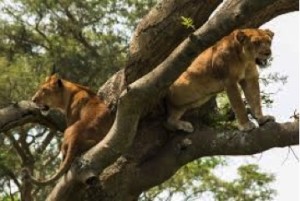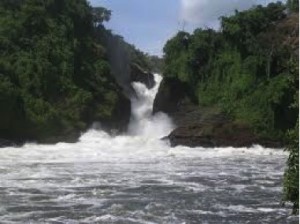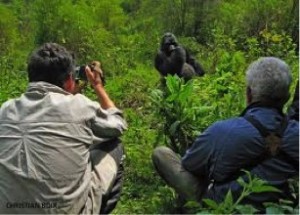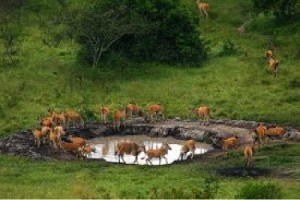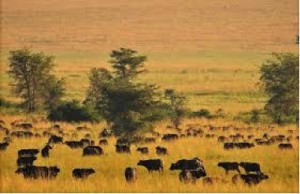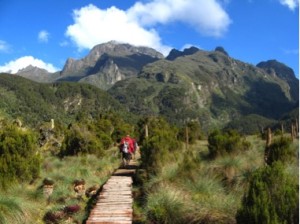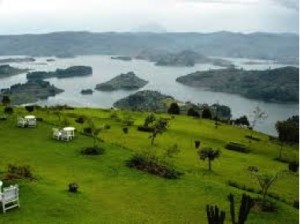Uganda is a unique destination with its varied features and hospitable people, dubbed the ‘Pearl of Africa’ by former British Prime Minister, Sir Winston Churchill, it is where the savanna of the Great Rift Valley meets the steaming forest jungles of Central Africa. In addition to volunteering with Community Growth, you can tailor-make a budget safari with us to the diverse national parks that dot Uganda.
Queen Elizabeth National Park
QENP occupies an estimated 1,978 square kilometres (764 sq m. It is now home to 95 species of mammal and over 500 species of birds. The area around Ishasha in Rukungiri District is famous for its tree-climbing lions,[3] whose males sport black manes, a feature unique to the lions in this area.
Safari tips – Famous for game drives in the Kasenyi plains and a boat cruise on the Kazinga Channel adjoining Lakes Edward and George. This circuit can be done in at least a week with a combination of mountain gorilla trekking and hikes at Mt. Rwenzori
Murchison Falls National Park
Murchison Falls presents you with a chance to experience diversity in wildlife and nature at best.
The Murchison National park is situated in the northern part of Albertine Rift Valley. A place where the massive Bunyoro escarpment amalgamate into the enormous plains of Acholi land. It’s well known to be one of Uganda’s ancient conservation areas. This park teems with wild game and the best game drives are at Buligi tracks.
Presently the spotlight of a visit to Murchison is the launch trip up the stream to observe the Falls and riverbank wildlife. The launch starts at 09.00 and 14.00 every day. The round trip takes 3 hrs. Another boat trip goes downstream from Paraa down to the papyrus delta at the point were the river enters into Lake Albert. This 4-5 hr return adventure provides a good chance of discovering the shoebill stork and different varieties of wildlife.
Bwindi Impenetrable National Park
Bwindi Impenetrable National Park is located in southwestern Uganda in East Africa. The park is part of the Bwindi Impenetrable Forest, and is situated along the Democratic Republic of Congo border next to the Virunga National Park and on the edge of the Albertine Rift. It comprises 331 square kilometres (128 sq mi) of jungle forests and contains both montane and lowland forest and is accessible only on foot.
Bwindi is famous for mountain gorilla tracking. Bwindi Impenetrable Forest is old, complex, and very biologically rich.[8] Diverse species are a feature of the park,[3] and it became an UNESCO World Heritage Site because of its ecological importance.[10] Among East African forests, Bwindi has some of the richest populations of trees, small mammals, birds, butterflies, reptiles, and moths. The park’s diverse species are partly a result of the large variations of altitude[10] and habitat types in the park,[16] and may also be because the forest was a refuge for species during glaciations in the Pleistocene epoch.
Bwindi is the ultimate destination for mountain gorilla tracking which is one of the most enthralling wildlife experience. A gorilla permit is quite expensive going at $600 and trackers can take advantage of low season months of April, May and November going at $450.
Lake Mburo National Park
The park has a variety of animals such as zebras, impala, buffaloes, and over three hundred (300) bird species. At 260 square kilometres (100 sq mi), the park is the smallest of Uganda’s Savannah national parks.
Lake Mburo National Park is a compact gem, located conveniently close to the highway that connects Kampala to the parks of western Uganda. It is the smallest of Uganda’s savannah national parks and underlain by ancient Precambrian metamorphic rocks which date back more than 500 million years. It is home to 350 bird species as well as zebra, impala, eland, buffalo, oribi, Defassa waterbuck, leopard, hippo, hyena, topi and reedbuck.
Together with 13 other lakes in the area, Lake Mburo forms part of a 50km-long wetland system linked by a swamp. Five of these lakes lie within the park’s borders. Once covered by open savanna, Lake Mburo National Park now contains much woodland as there are no elephants to tame the vegetation. In the western part of the park, the savanna is interspersed with rocky ridges and forested gorges while patches of papyrus swamp and narrow bands of lush riparian woodland line many lakes.
Lake Mburo is the only park where you can see zebras in Uganda. A convenient destination to break the long drive to Gorilla tracking
Kidepo National Park
Kidepo Valley National Park lies in the rugged, semi arid valleys between Uganda’s borders with Sudan and Kenya, some 700km from Kampala. Gazetted as a national park in 1962, it has a profusion of big game and hosts over 77 mammal species as well as around 475 bird species.
Kidepo is Uganda’s most isolated national park, but the few who make the long journey north through the wild frontier region of Karamoja would agree that it is also the most magnificent, for Kidepo ranks among Africa’s finest wildernesses. From Apoka, in the heart of the park, a savannah landscape extends far beyond the gazetted area, towards horizons outlined by distant mountain ranges.
During the dry season, the only permanent water in the park is found in wetlands and remnant pools in the broad Narus Valley near Apoka. These seasonal oases, combined with the open, savannah terrain, make the Narus Valley the park’s prime game viewing location.
Kidepo National Park is Uganda’s true wilderness.
Rwenzori National Park
The Rwenzoris – the fabled Mountains of the Moon – lie in western Uganda along the Uganda-Congo border. The equatorial snow peaks include the third highest point in Africa, while the lower slopes are blanketed in moorland, bamboo and rich, moist montane forest. Huge tree-heathers and colorful mosses are draped across the mountainside with giant lobelias and “everlasting flowers”, creating an enchanting, fairytale scene.
Rwenzori Mountains National Park protects the highest parts of the 120km-long and 65km-wide Rwenzori mountain range. The national park hosts 70 mammals and 217 bird species including 19 Albertine Rift endemics, as well as some of the world’s rarest vegetation.
The Rwenzoris are a world-class hiking and mountaineering destination. A nine- to twelve-day trek will get skilled climbers to the summit of Margherita – the highest peak – though shorter, non-technical treks are possible to scale the surrounding peaks.
For those who prefer something a little less strenuous, neighboring Bakonzo villages offer nature walks, homestead visits home cultural performances and accommodation, including home-cooked local cuisine.
Rwenzori National Park offers you quite a different experience in Africa
Lake Bunyonyi
Lake Bunyonyi (“Place of many little birds”) lies in south western Uganda between Kisoro and Kabale close to the border with Rwanda. Located at 1,962 m (6,437 ft) above sea level, it is about 25 km (15.5 mi) long and 7 km (1.35 mi) wide. The depth of the lake is rumored to vary between 44 m (144 ft) and 900 m (2,952 ft), which if true would make the lake the second deepest in Africa. It is one of the few lakes in the region that is known to be free of bilharzia and safe for swimming, however, this claim is not verifiable and patrons of the lake have tested positive as recently as 2012. The lake appears on the 5,000 Ugandan shilling note under the title “Lake Bunyonyi and terraces”.
The lake is undoubtedly the loveliest lake in Uganda and offers you quite nest after the gruelling mountain gorilla tracking.
Booking
A considerable percentage goes towards the Community Growth project and for more and choosing your perfect safari while volunteering in Bujagali please write to afrikabudgetsafaris@gmail.com or call +256706276529





